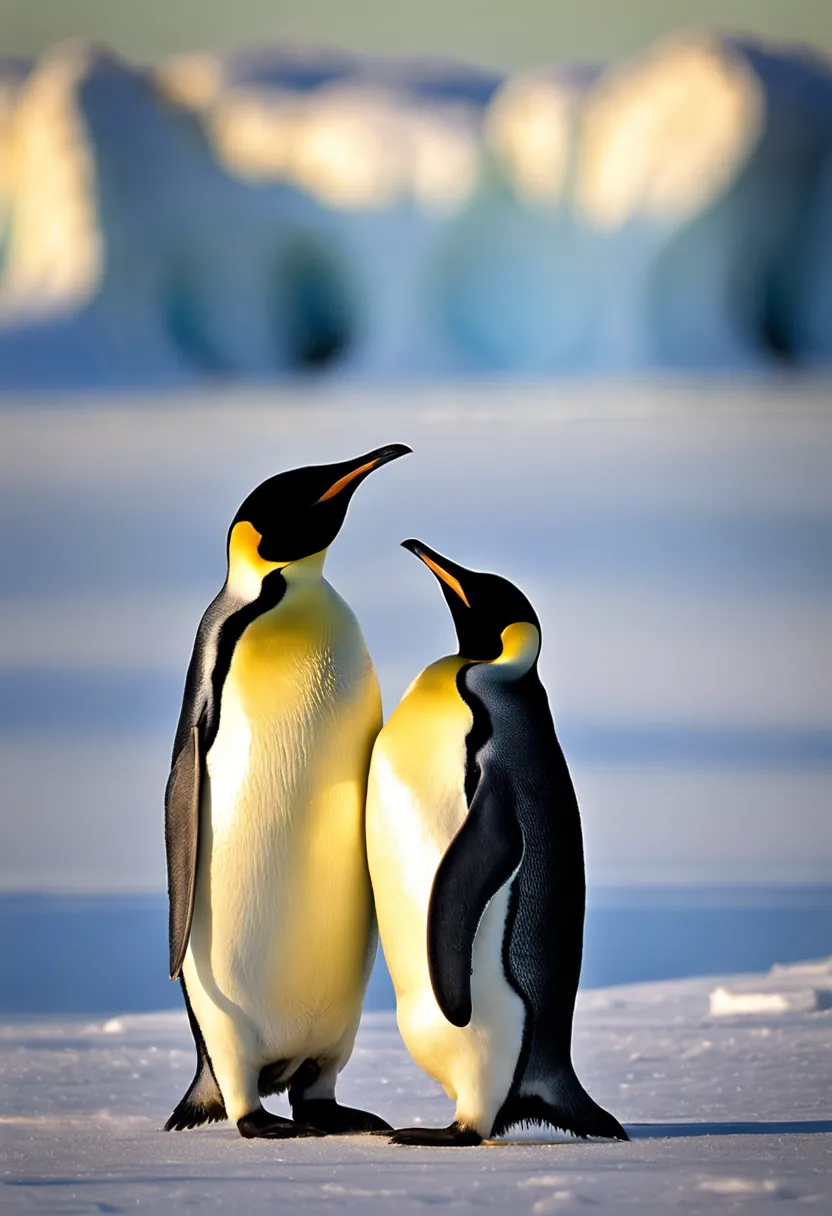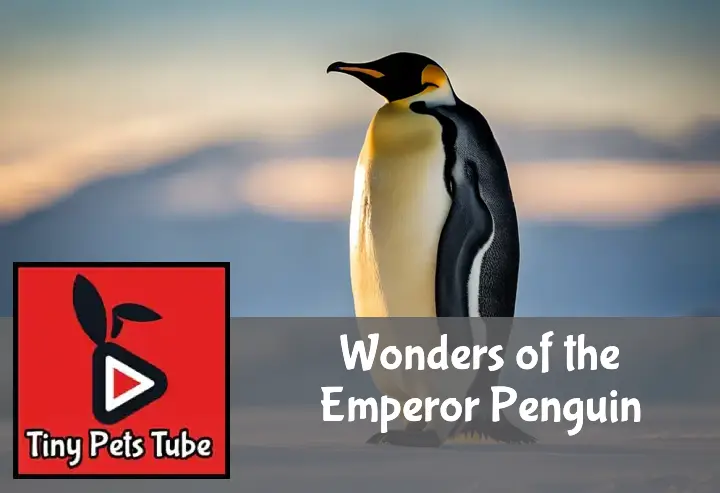Ever had one of those days where you just can’t shake off the cold? Now, imagine surviving in Antarctica, the coldest place on Earth! Sounds impossible, right? Well, not if you’re an Emperor Penguin. These guys are like the superheroes of the bird world. One glance at the Wonders of the Emperor Penguin and you’ll see what I mean.
These birds have some pretty cool tricks up their sleeves (or should I say flippers?) to survive in frigid temperatures that would make even a Yeti shiver. Stick around and we’ll dive deep into their fascinating world. Keep reading about Wonders of the Emperor Penguin!
Key Takeaways
- Emperor Penguins are the tallest and heaviest of all penguin species.
- They can dive deeper and stay underwater longer than any other bird.
- Their unique adaptations, such as a layer of fat and tightly packed feathers, help them survive Antarctica’s harsh conditions.
- They have an intricate social structure, including a breeding cycle that involves males incubating eggs while females hunt for food.
- Emperor Penguins are considered near threatened due to climate change.

What Makes Emperor Penguins Unique?
Well, let’s dive into the Wonders of the Emperor Penguin and explore their uniqueness. You see, these fellas are not just your average birds. They’ve got some pretty cool tricks up their sleeves (or should I say wings?) that make them stand out in the Antarctic crowd.
Physical Characteristics
First off, let’s talk about their size. These guys are big! In fact, they’re the largest of all penguin species. With an average height of 1.2 meters (that’s about 4 feet), they’re practically NBA material! Their size isn’t just for show though; it helps them retain heat in their frigid Antarctic home.
Now onto their coloration patterns. You might think black and white is a bit boring, but for Emperor Penguins, it’s a matter of survival. Their dark backs blend with the ocean depths when viewed from above, while their white bellies camouflage against the bright surface when seen from below. Sneaky, eh?
And let’s not forget those yellow patches on their necks – like wearing a fancy scarf in the middle of winter! This unique trait helps identify individual penguins among thousands in a colony. Talk about standing out in a crowd!
Adaptations for Extreme Cold
Alrighty then, how do these birds survive in such extreme cold? Well, they have some nifty cold weather adaptation strategies up their flippers.
Firstly, they’ve got this amazing feather insulation system going on – think of it as wearing multiple layers on a really cold day. Their feathers trap air which gets warmed by body heat to keep them toasty even when temperatures drop below freezing.
But wait there’s more! When it gets super chilly, these guys huddle together for warmth – like one big feathery cuddle party! This penguin huddling behavior is actually an efficient way to conserve heat and protect the most vulnerable members of the group. Teamwork makes the dream work, right?
Diving Abilities
Now, let’s plunge into their diving abilities. These birds are like the Olympic divers of the animal kingdom. They hold the record for deepest bird dive – can you believe they can go down to 535 meters? That’s deeper than the Empire State Building is tall!
And it’s not just about how deep they can go, but also how long they can stay underwater. With an average dive lasting around 20 minutes, these birds could watch a whole sitcom episode underwater!
So how do they manage this? Well, it’s all thanks to some clever physiological diving adaptations. They have a high concentration of myoglobin in their muscles which stores oxygen for use during dives. Plus, their bodies can suppress non-essential bodily functions to conserve oxygen – kind of like putting your phone on airplane mode to save battery.
So there you have it folks! The Emperor Penguin – a unique blend of size, style, cold weather resilience and deep-sea diving skills that make them one heck of an Antarctic superstar!
How Do Emperor Penguins Reproduce?
The Wonders of the Emperor Penguin reproduction cycle are truly a marvel to behold. Their intricate mating rituals, egg incubation process, and shared responsibilities in chick rearing and parental roles make them one of nature’s most fascinating creatures.
Mating Rituals
When it comes to love, Emperor Penguins don’t mess around. The breeding season rituals kick off with a charming Antarctic mating dance that would put even the best ballroom dancers to shame. This courtship behavior is more than just a fancy footwork; it’s an essential part of their mate selection process.
But wait, there’s more! These penguins also engage in pair bonding activities like mutual preening and calling out to each other in their unique voices. It’s like their own version of whispering sweet nothings into each other’s ears. Ain’t love grand?
Egg Incubation Process
After all the dancing and romancing, it’s time for some serious business – egg incubation. And here’s where our male Emperor Penguins really shine. They take on the crucial duty of keeping the precious egg warm in Antarctica’s brutal cold.
These dedicated dads balance the egg on their feet, covering it with a warm layer of feathered skin called a brood pouch. Talk about stepping up! This Emperor Penguin egg care strategy is vital for survival during the harsh Antarctic breeding cycle.
And while daddy does his thing, mommy goes off on a fishing trip to stock up on food for when the little one hatches. It’s teamwork at its finest!
Chick Rearing and Parental Roles
Once the chick hatches, both parents get down to business with feeding and protecting their fluffy offspring from predators. The chicks are fed regurgitated fish by both parents – not exactly gourmet dining but hey, it works!
This parental cooperation in chick rearing is a sight to behold. While one parent goes off to fish, the other stays behind, keeping the chick warm and safe from predators. It’s like a well-oiled machine, each part working in harmony with the other.
And when it comes time for fledging period activities, both parents guide their young through this crucial stage of life. Despite the harsh conditions and threats lurking around every corner, these penguins prove that teamwork really does make the dream work!

What Threats Do Emperor Penguins Face?

In the icy realms of Antarctica, the Wonders of the Emperor Penguin are under siege. These charismatic creatures face a myriad of threats that jeopardize their survival and disrupt their ecosystem.
Natural Predators
Emperor penguins have a few enemies in the wild, but two stand out: seals and orcas. These emperor penguin predators are notorious for their relentless pursuit of these flightless birds. Seals often lurk beneath ice floes, waiting to snatch an unsuspecting penguin during its dive.
On the other hand, orcas, with their coordinated hunting strategies, pose a significant threat too. The impact of this predation is twofold. It regulates penguin populations but also influences penguin survival strategies, forcing them to adapt and evolve.
Climate Change and Its Impact
Climate change is another major player in the game of emperor penguin survival. As temperatures rise, their icy habitats are melting away, leading to drastic climate change effects on penguins.
Food scarcity is another issue as warmer waters affect krill populations – a primary food source for these birds. Furthermore, unpredictable weather patterns can disrupt emperor penguin breeding cycles causing significant challenges for these Antarctic dwellers.
Human Interference
Humans may not live in Antarctica, but our actions still reach its shores. Pollution finds its way into these remote regions affecting not just emperor penguins but all Antarctic wildlife.
Overfishing depletes fish stocks leaving less food for hungry beaks while tourism can disturb breeding colonies if not properly managed. However, it’s not all doom and gloom! By adopting sustainable fishing practices and promoting eco-friendly tourism we can minimize our negative impact on these magnificent creatures and contribute positively towards penguin conservation efforts.
How Are Emperor Penguins Important to the Antarctic Ecosystem?
Well, let’s dive right in! The Wonders of the Emperor Penguin aren’t just about their tuxedo-like appearance or their fascinating mating rituals. Nope, these fellas play a significant role in the Antarctic ecosystem too!
Role in the Food Chain
Now, you might be wondering how these waddling wonders fit into the food chain. Well, it’s all about balance, my friend! Emperor penguins feast on squid and fish but their favorite snack is krill. These tiny shrimp-like critters are abundant in Antarctic waters and are a crucial part of the Emperor penguin diet.
But it ain’t all feasting for our penguin pals. They’re also on the menu for some Antarctic predators, like leopard seals and killer whales. This predator-prey relationship helps maintain an ecosystem balance. So you see, they’ve got a pretty important gig in this icy wilderness.
Indicator of Climate Change
But wait, there’s more! These birds are not just part of the food chain; they’re also climate change detectives! Changes in penguin population decline can signal shifts in our environment due to climate change effects.
For instance, if there’s less ice around (thanks to global warming), that means fewer places for penguins to breed and less krill for them to eat. This could lead to a drop in their numbers – a big red flag for scientists monitoring Antarctic ice melting impact.
And what about future implications? Well, if current trends continue, we could see major changes in Antarctic biodiversity. But by keeping an eye on our feathered friends, we can make better ecological predictions and hopefully take steps to protect this unique ecosystem before it’s too late.

To Wrap Up
We’ve journeyed through the icy realms of Antarctica, exploring the Wonders of the Emperor Penguin. These tuxedo-clad survivalists, tougher than a frozen meatloaf, have shown us how to thrive in extreme conditions.
Let’s take a leaf from their book – or rather, a feather from their cap – and embrace life’s challenges with unwavering determination. Stay curious, just like our flippered friends!


